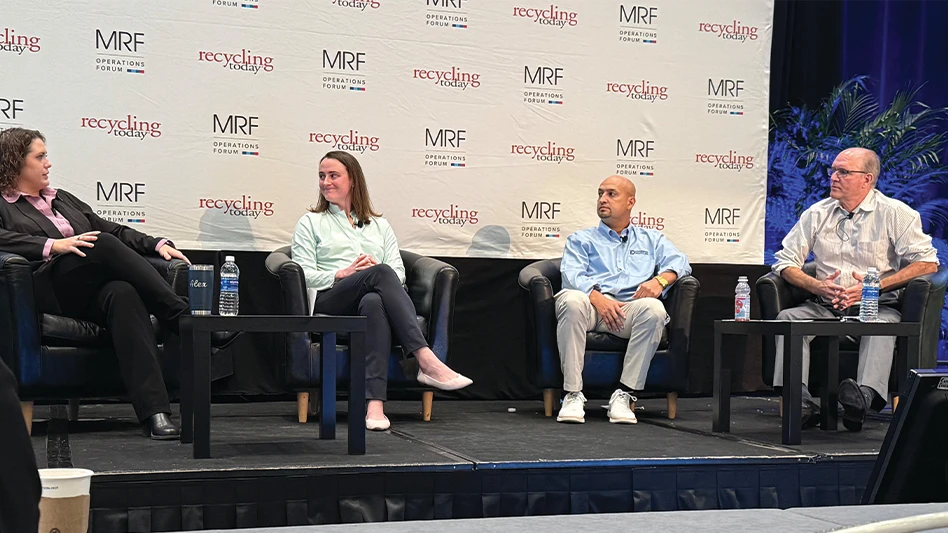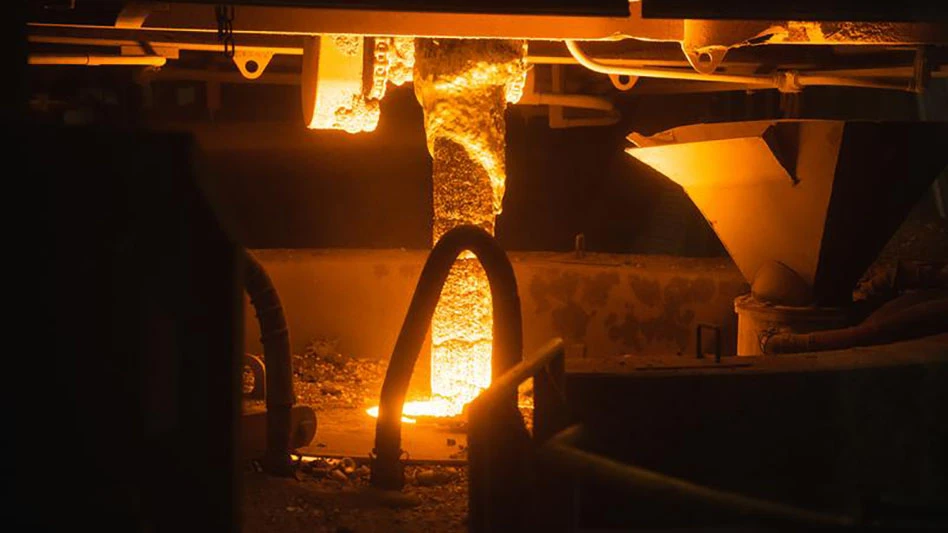Ferrous scrap markets have been at a high level for the past several years, with strong demand and high prices. Although there is some softening in the markets late in 1995, most industry watchers forecast an improvement at the beginning of the new year, with conditions remaining steady throughout 1996.
“1995 came in with a bang and went out with a bit of a whimper, but overall, when you total everything up, it was a very good year,” says John Jacobson, president of Jacobson & Associates, Rochester, N.Y.
The United States manufacturing base is more competitive than in the past, and even the low points of the cycle are higher, he adds. “So the downside risks are much lower, because not only are steel companies more competitive, but their major customers – the auto producers and all the machinery companies – are also more competitive.”
Several analysts agree that the slower conditions in the fourth quarter of 1995 can be attributed to an industry correction. At the end of 1994 and the beginning of 1995, there was some concern in the market about getting sufficient supply of flat-rolled steel, which is one reason steel imports were high at that time.
“Then that concern about not getting enough disappeared,” says Jacobson. “So there was a period – starting in the spring and carrying over until recently – that people, particularly service centers, backed off on some new buys of steel. That resulted in somewhat lower operating rates by producers.”
This correction is, for the most part, finished. As a result, once general economic conditions pick up in the beginning of the new year, ferrous scrap markets are likely to pick up, as well.
“Ferrous scrap at the beginning of the year was extremely strong, and I think that as the year went on, prices adjusted to reality, which is what should happen,” adds Arnie Gachman, president of Gachman Metals & Recycling, Fort Worth, Texas. “I don’t think we see gloom and doom out there because order books are still in reasonable shape for 1996 business.”
However, the recent period of economic expansion in the U.S. has already lasted longer than such recoveries often do, commented Steve Wulff, vice president of planning for The David J. Joseph Co., Cincinnati, at a ferrous scrap forum held this fall in Chicago by American Metal Market.
“By past standards, this recovery is mature, and it would not be wholly inappropriate to begin worrying a bit about a recession,” he said. “There is an incentive to keep the economy moving another year because of the election in 1996, so the economy will receive some support from politicians. But the rate of growth is slowing.”
DEMAND FACTORS
The automotive industry, which boomed in 1994, has been slower in 1995. This has resulted in a slowdown of the flat-rolled steel market. On the other hand, the construction industry has been fairly healthy, so demand for structural steel has remained strong. The use of steel in residential framing has been growing in popularity, especially with significant increases in the price of lumber.
Over the next five to 10 years, this sector is expected to add as much as 5 million tons in additional steel demand, according to Jacobson. “It’s just a matter of getting more contractors involved,” he explains. “It will take a while, but it looks very good. In fact, a number of mills have put in new coating lines directed almost exclusively at this new market.”
Exports of steel have grown substantially in the fourth quarter, which is keeping raw steel production up, says Jacobson. “Year-to-date exports through August of finished steel were 4.1 million tons, and so I think you’ll see well over 6 million tons for the year, compared with 3.8 million in 1994. In terms of scrap, usually 8 to 10 million tons a year of ferrous scrap is exported, and tonnages in some of the recent months are quite high, so I think we’ll end up with a number in 1995 that’s similar to 1994.”
In fact, the U.S. appears to be headed towards a four-year high in scrap exports, said Alter Goldstein, manager of international scrap for Glencore Ltd., Stamford, Conn., speaking at the AMM ferrous scrap forum. Freight rates have risen during the past three years, reaching a high in mid-1995 but since then falling back 25 percent, he said. High rates tend to constrict exports, as the U.S. is competing with shipments out of Northern Europe which are closer to Asian markets.
A weaker dollar often means the U.S. is more competitive for export while a stronger dollar usually means Europe is more competitive for export, said Goldstein. Mid-summer, the dollar strengthened considerably, which hurt exports.
“Suddenly, the U.S. dollar was much stronger against the yen and the Deutsche mark,” he explained. “The appreciation amounted to, in some cases, as much as 8 percent to 10 percent against the Deutsche mark and the Dutch guilder and was much higher – about 25 percent – than the Japanese yen. This changed the market suddenly. Export demand for scrap from Germany and France and other European countries shot up, throwing more scrap onto the export market, and with cheaper freight rates, U.S. scrap definitely lost its attractiveness.”
The U.S. export market is currently fairly weak, but most scrap suppliers enjoyed an excellent business year during 1995, said Goldstein.
“With the winter months almost upon us, the flow of scrap usually drops, which also eventually can signal better prices to be paid by domestic and overseas mills,” he said. “There is still good demand from the Far East, even though the prices continue to drop slightly from order to order. But again, we are perhaps near a point where the overseas mills will not be able to buy at ever lower prices and will be forced to pay higher.”
STEEL CANS IN DEMAND
“It was a great year – 1995 was as good as 1994,” says William Heenan, president of the Steel Recycling Institute, Pittsburgh. “And really, you had stable pricing.”
SRI did some analyses in 1995 to compare the cost of processing steel cans with the average value most MRFs received for the material. The results looked good for recycling profits, says Heenan. “We found that we were adding money to the coffers of communities across the United States, because their cost of processing was less than the money they were receiving if they were doing a good job of selling their cans.”
The recycling rate for cans is likely to remain in the 50 percent to 60 percent range, and not reach SRI’s goal of 66 percent by the end of 1996, he adds. But there will be more steel can supply as Chicago’s curbside recycling program comes online, and cities such as New York add aerosol cans to their collection programs.
Ferrous prices softened in 1995, but not appreciably, says Heenan. “They’re down $6 here and $8 there, but you’re still seeing numbers between $120 and $150. Prices going up $5 and down $5 is not a problem. It’s the major swings – jumping $30 or dropping down $20 at one time – that really hurt the infrastructure.”
North Star’s Arizona minimill will help displace some steel imported into the West Coast, he adds, improving scrap prices.
There is an increased demand for steel cans, he says, with some mills unable to get the supply of cans they want. Demand for steel cans has increased dramatically during the last five years, he adds. “The reason is very simple – it’s that the price of cans out there is less than the value of replacing a No. 1 bundle. The best thing I can say about cans this year is that people are out there saying ‘where can I get more?’”
1996 SCRAP STABILITY
For 1996, Wulff predicts relative stability in scrap demand and scrap prices compared with 1995. However, if the economy does weaken more than expected, this could result in significant reductions in scrap prices, he said.
“The wild cards are the strength of foreign economies and their interest in exporting steel to the U.S. or importing steel from the U.S., and the availability of pig iron and other substitutes from offshore,” said Wulff. “Another wildcard is old man winter versus scrap consumers inventories – weather is a huge variable these days. Rain, sleet and snow may not deter the postal service from its appointed rounds, but it can wreak havoc on scrap deliveries. In fact, it could be particularly nasty if mill inventories are already low.”
Upward pressure to scrap prices in 1996 could be caused by ongoing problems with rail car availability, possible freight rate increases and a reduced supply of both industrial and obsolete scrap.
“Other consumers could use the recent market weakness as a buying opportunity, thereby propping up demand and prices,” said Wulff. “Even if scrap prices fall, the news is worse for consumers than scrap processors. What would drive the scrap prices down would be a weakness in demand caused by a shortage in markets for steel products.”
And although many herald the addition of new steelmaking capacity in 1996 as a boon to scrap demand, there is some question about the long-term effect it have on the scrap market, according to Gachman. “If there’s more availability of finished steels, does that hurt us? Finished inventory may balance out the demand for scrap as time goes on.”
But he is optimistic that once the new mill capacity gets up to speed, it will likely be very efficient, and will drive out less efficient capacity either domestically or overseas.
“And so long as there are fair trade practices where you don’t get into any dumping or tariffs, steel will flow to the demand at the best possible price, and there will be that much more demand for scrap,” says Gachman.
NONFERROUS STRENGTH
It was an exciting year in aluminum as prices headed toward the $1.00 a pound mark, says Stanton Moss, president of Stanton Moss, Bryn Mawr, Pa. He adds that prices are now falling back to about 70 cents a pound and that should continue into next year as supplies become more plentiful.
“The main reason for the price increase during the beginning of the year was due to an agreement between Western and Russian primary producers to limit aluminum production,” he says. “That agreement is over now and supply is picking up. Plus, the auto market is softening here and overseas, so demand is easing in that area.”
There is a slackening in aluminum demand, but it is not significant, according to Marvin Fink, president of Allied Metal, Chicago. “There was about a six-month period in the middle when demand was really strong,” he says, “and most of the casting plants we sell to were operating on a seven-day schedule. Now they have slowed somewhat, maybe down to a six-day schedule.
“I think we will start the first quarter of 1996 strong,” continues Fink. “Most of the die casters have already locked in at the 70-cent price which tells me they like their margins with that price and that they think the price may go up in the new future.”
Patricia Plunkert, aluminum specialist for the U.S. Bureau of Mines, Washington, agrees with Fink and Moss, but says the production agreement with Russia will remain in force until the end of this year. “I think what we are seeing is that capacity is starting to be turned on in dribs and drabs in anticipation of the agreement ending.”
According to Plunkert, in 1994, primary aluminum production in the U.S. was at 3.3 million metric tons, and the Bureau is forecasting 3.35 million for this year. Supplies of secondary aluminum are expected to increase from 3.1 million metric tons to 3.3 million.
“There wasn’t any excessive supply in the global market during most of the year; now that is changing,” says Plunkert. “There is a new primary smelter coming on line in South Africa, but besides that it has been very quiet.”
Aluminum beverage cans also had a strong year, as prices flirted with the $1.00 a pound mark earlier in the year, then backed off. Although prices fluctuated mainly between 60 cents and 80 cents through most of 1995, the prices were more than adequate for processors and sellers.
“Pricing for aluminum used beverage containers at the beginning of the year was about 80 cents a pound,” says Emil Kane, Schupan & Sons’ UBC broker based in Chicago. “That was great, but it was a scary number – it was just too high. Now, it is at 60 cents which is still a hell-of-a-good number, but more realistic.
“All year we have had a good numbers to work with,” he continues. “The pricing has been good, the recycling rates have been good, and if you did not make money in this market this year, then you should not be in the business. The market was not below the 55-cent mark all year long.”
Although the recycling rate of aluminum cans is up, Kane is a little concerned about the recent softening in new can sales. “Pepsi and Coke new cans sales are down about 3 percent to 5 percent as they are shifting more production to plastic bottles,” he says.
While he is not willing to speculate on the market’s future in 1996, Kane will say that everyone in the industry is watching the London Metal Exchange closely. “Before, everyone was watching how Alcoa was pricing, but I think Alcoa has now started to concentrate more on being a business and not subsidizing its UBC collection operation. As long as the cans are being removed from the waste stream and returned for recycling, then they are happy.”
ROBUST COPPER MARKET
Copper markets remained strong as prices floated between $1.24 and $1.45 through much of 1995, which was quite healthy, and even went over the $1.45-per-pound mark for the first time in five years.
“Demand throughout the world is very good,” says Mike Ashworth, manager of metals procurement for Southwire Co., Carrollton, Ga. “The U.S. market is very strong, and European economies are strong and getting stronger. Japan is not back to its level of strength, but is improving. Overall, copper looks robust on the demand side.”
And in China, markets there are “beating on doors for copper,” according to Michael Friedman, president of Friedman Metals Brokerage Co., York, Pa.
Copper was an enigma at the beginning of the year as prices kept falling despite a continuing supply deficit in the U.S. The contradictory movement in price had analysts scratching their heads, but only for a while. Prices finally picked up in May in response to the tight supply.
The market will likely see $1.30 per pound again, but will not rise to levels above $1.50, speculates Donald Lewon, president and CEO of Utah Metals, Salt Lake City. “The market’s strength is in demand,” he says. “Maybe sustained prices of more than $1.40 are in the future.”
But Daniel Schwab, executive vice president of Franklin Smelting & Refining Corp., Philadelphia, says he feels prices will go higher than the mid $1.40s and even beyond $1.50.
“Some were predicting copper losing market share because of glass fiber cable, but copper just keeps growing,” he says. “The market will stay strong, because there are no new supplies coming on line. So, I would say that the market has more potential to go up than down.”
SPECIAL ALLOYS GAIN GROUND
As for special alloys, the titanium market is gaining ground as this commodity continues to move up in price due to the boost in aircraft sheet prices and an aging aircraft fleet that needs updating.
Global unit aircraft deliveries are expected to increase 10 percent in 1996 and 1997, respectively, and this is a major factor because planes use a lot of titanium. For example, the new Boeing 777 is 12 percent titanium by weight.
“The industry finally appears to be headed out of the slump that it has been in for the past four years,” says Nucgaekl Metz, director of marketing for Timet, a titanium processor in Denver.
The nickel market also has been strong, with premiums being paid 15 to 18 cents above LME prices. “The nickel market is surprisingly good,” says Si Wakesburg, LME New York bureau chief and consultant to the Institute of Scrap Recycling Industries, Washington, “and this means the stainless market will be good. Chrome, molybdenum and cobalt all depend on nickel.”
POST-CONSUMER GAINS
Indicators for post-consumer recycling were positive in 1995. Prices for just about all types of post-consumer materials – with the exception of a mid-year plummet in the paper market – remained at healthy levels; state and local municipality recycling rates continued to rise; and new processing facilities and equipment are still coming on line in numbers that present a strong growth picture.
“Recycling is working,” Mark Lichtenstein, president of the National Recycling Coalition, Washington, reminded attendees at NRC’s September convention in Kansas City, Mo.
Indeed, according to Franklin Associates, Prairie Village, Kansas, the price of curbside recyclables collected went from an average of $46 per ton in 1993 to $165 a ton in 1995. This made many curbside collection programs profitable for the first time.
Another recent report from Governmental Advisory Associates Inc., Westport, Conn., reveals that there are currently 337 material recovery facilities operating in the United States – an increase of 52 percent over 1993. The report also says that there has been an upward trend in public sector ownership of MRFs, and that older ones are shutting down and paving the way for newer, more modern facilities. These new facilities are being outfitted with the latest sorting technologies.
On the supplier side, recycling equipment manufacturers are indicating that they are trying to keep up with a demand for processing equipment that stayed strong throughout the year. Companies are reporting order backlogs, and plant expansions are underway to meet that demand.
In addition, many processing companies are expanding. Companies like Prins Recycling, Fort Lee, N.J., and Weyerhaeuser, Federal Way, Wash., for example, have been in heavy expansion and acquisition modes throughout 1995. Prins is expanding mainly in the East, and Weyerhaeuser has been purchasing collection and processing facilities all over the U.S. Currently, the company has 35 recycling operations, acquiring eight this year alone.
Local and state governments are aiding the recycling effort, too, by providing tax credits, recycling economic zones and grants and loans. Also, recycling alliances are being formed between government and the private sector to aid in areas such as appliance recycling and the buying of recycled-content merchandise.
Still, with all the positive actions that are taking place, there are areas for concern. Lichtenstein urges the industry as a whole to continue forging ahead. “Although the markets are good in terms of prices, we still need to address the shortages in paper and plastic, for example,” he says.
PAPER FLUCTUATIONS
The paper market lost steam after the first half of the year, as prices of most grades fell sharply from the record levels they had achieved. “We saw strong prices in all grades and record highs in post-consumer grades during the first half of the year,” says Dan Sandoval, editor of Fibre Market News, Cleveland. “The second half saw prices tumble, approaching price levels that were seen at the beginning of the decade when markets were in the doldrums.”
The reason for the downturn in pricing was because mills began to build inventories, and because those that were running at full capacity began to slow due to a softening in demand for finished product, especially in paperboard. Plus, many mills were taking down time to force feedstock prices lower and to bring supply in balance with demand.
These adjustments have resulted in a significant decrease in demand for feedstock across the board including recovered fiber.
However, Sandoval and others don’t think the low prices will last for long as markets are expected to pick up again. “When inventories get back in line with capacity, that will start to pull more tonnage and market demand will pick back up,” says Sandoval.
Also, 1995 was a year that experienced a lot of mill capacity coming on line – more than in recent years. Several large users of recovered feedstock began operations, especially in old corrugated cardboard, which was one of the primary reasons that OCC increased as much as 1,000 percent in price.
“Everyone needs to realize that this is a commodity market,” says Doug Gardner, president of Accurate Paper Recycling Inc., Tampa, Fla., whose company moves about 2,000 tons of paper per month. “In the words of J.P. Morgan, ‘Markets will fluctuate,’ and this year the paper market really fluctuated. If prices go up higher, they are going to come down harder. That’s what we are seeing now. So, this is a learning experience for everyone in the industry.”
Gardner says that many people in the market are suffering because they went to a commingled program, and now mixed paper has lost a great deal of value and is actually costing dealers money. “We kept our paper separated,” says Gardner. “We did not make the switch, and are still dealing mainly in high grades. We have our customers separate it, or we do it here.”
At the recent Paper Stock Industries’ Annual Fall Meeting held in Coral Gables, Fla., attendees conceded that the near-term markets would be rocky and expressed optimism that markets would rebound. Several brokers even noted that OCC markets had started to inch back up.
Still, many attendees at the meeting felt that there would not be any significant improvement in price or demand until next year at the earliest. A number of the speakers pointed out that some specific actions would have to take place in order for the market to rebound. Those include a reduction of the raw material and finished product inventories; a strengthening of the export market; and an overall improvement in the U.S. and Canadian economies.
One new service that promises to hook up buyers and sellers of different paper grades and offer a benchmark for pricing is the much ballyhooed Chicago Board of Trade Recyclables Exchange. Although CBOT was of particular interest at the meeting, none of the attendees indicated they had attempted to use the new electronic service.
It is always difficult to make accurate predictions, but Jeri Winkleback of the Aseptic Packaging Council, Tallahassee, Fla., believes that polycoated paper will be more in demand.
“An increasing number of mills want polycoated paper that is normally used in the food container business, and there are several reasons for this demand,” she says. “One, the paper is usually of a higher quality. Two, no de-inking is required because the print is on the polycoat itself. And three, the food these items contain comes in contact with the polycoat, and not the paper. There’s also not a problem with glue, wax or stickies on polycoat.” Currently, she says there are 10 mills – all in the South – that are purchasing post-consumer polycoated paper.
PLASTICS ROLLER COASTER
The demand for recycled plastics is expected to grow 13 percent annually through 1998. Fueling that demand will continue to be recycled content legislation, an expanding collection network, improvements in sorting technology and increased applications development, according to the Freedonia Group, a research firm in Cleveland.
For 1995, plastic recyclers probably had the biggest roller coaster ride of all the recycling commodity segments as prices for recovered PET and HDPE hit record highs, but crashed soon thereafter. “Prices were just bid up too fast,” says Alan Logan of the Ensley Corp., North Canton, Ohio. “What hurt was that there was an adversarial relationship between recyclers and markets that burdened the industry. When post-consumer regrind was in tight supply, recyclers wanted to hold out for higher prices and bids, instead of selling at the current market price. Now it is the mills’ turn to play hardball as prices have softened. So I think we had a unnecessary situation where there was some milking of the market going on.”
The recycled HDPE market got its strength this summer from a lack of virgin HPDE capacity, while the PET market was benefitting from a shortage of supply overseas in Asia and a strong demand domestically. Then, virgin HDPE capacity came up to speed and virgin prices fell and recycled HDPE followed as prices crashed.
“Natural HDPE is still going down in price,” says Logan, “and it may be the same price as colored HDPE in the near future, which will be the first time that has ever happened. Recycled HDPE just cannot sustain its price levels because virgin keeps going lower.”
In the PET segment, exports have slackened and that market is now seeing processed PET fiber being imported in greater quantities. “Those incoming shipments are damaging the PET fiber markets causing losses to domestic processors by bringing prices down,” says Logan. “So there has been some flip-flopping concerning exports and imports. Baled PET is just not going overseas as much. I think that the finished goods that the Chinese were making were just too expensive and people stopped buying them, plus there were some problems in processing and contamination.”
GLASS QUALITY CONCERNS
Although glass recycling rates have been increasing for the past seven years, problems continue within the industry, such as the cost of transportation and continuing low prices, the growth of third-party processors and quality control as ceramic and tempered glass contaminants are increasingly a problem.
Mixed glass is another big problem that will not go away. Its only uses appear to be as a sub-base for roads or filler in asphalt.
“I would say that the main problem that we have had with glass this last year and in the past, is that cullet is coming back unsatisfactory from MRFs because of high belt speed, too many transfers or excessive dumping on the floor,” says Lewis Andrews, president of the Glass Packaging Institute, Washington. “We are trying to address that.”
As for prices during 1995, they were steady and are currently holding, with no major swings. “Both demand and price should both be steady; glass does not really fluctuate the way other commodities do,” says Charles Porta, president of Container Recycling Alliance, Chicago.
There are currently 69 glass container plants in the U.S., and, according to Lewis, each one wants color-sorted, contaminated free post consumer bottles and jars. “No one is cutting back on the use of cullet,” he says. “Plants want it and it is strong right now.”
Also pushing supply will be minimum content laws that Lewis says are already being enacted, such as one in California that will require 35 percent post-consumer cullet in glass bottles beginning in January 1996.
This year was also one of consolidation and internationalization in the industry. “More plants closed this year and others merged or were bought than in recent years past,” says Douglas Gibboney, regional director GPI. “Because of that, 90 percent of the glass container market is controlled by three companies in the U.S. In addition, more companies are doing business overseas, and more foreign companies are coming here.
“Glass has traditionally been a stable market,” he continues. “Overall, supply is matching demand. I agree with others in the industry that our biggest problem is correcting problems with commingled programs and mixed glass, so we have to address those issues for the future.”
The authors are editor and managing editor of Recycling Today.

Explore the December 1995 Issue
Check out more from this issue and find your next story to read.
Latest from Recycling Today
- AF&PA releases 2023 paper recycling rate, unveils new methodology
- ARA names new president
- Aurubis invests in Lünen, Germany, site
- ILA, USMX negotiations break down
- Van Dyk hires plastics industry vet to expand footprint in PRF sector
- Li-Cycle closes $475M loan with DOE
- Report highlights consumer knowledge gaps in lithium battery recycling
- AMP names CEO





